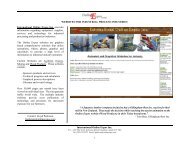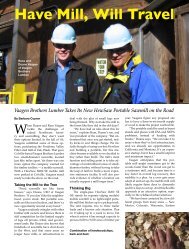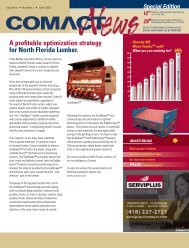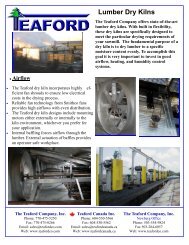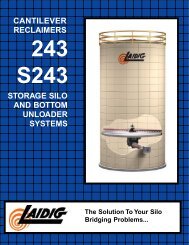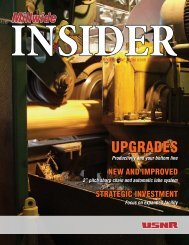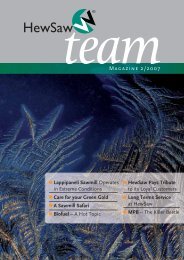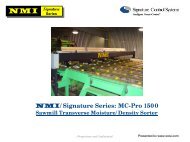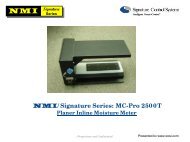Create successful ePaper yourself
Turn your PDF publications into a flip-book with our unique Google optimized e-Paper software.
S A W M I L L U P G R A D E<br />
The Hew Saw R200 Plus fired up in<br />
January 2005. Note that logs can be kicked<br />
off ahead of the infeed in the rare cases<br />
where that is required.<br />
Familiar Territory<br />
Ledwidge Lumber relies on a pair of Hew Saw lines to recover quality<br />
studs from its private log supply – An older MSA races through the<br />
smallest of small logs, while a brand new R200 Plus makes the most of<br />
larger logs.<br />
by Scott Jamieson<br />
o with what you know. That may well describe recent upgrades<br />
at Ledwidge Lumber of Enfield, NS. The family-owned stud<br />
mill replaced its ageing twin-saw line with a new optimized Hew<br />
Saw R200 Plus small-log line, joining an existing Hew Saw line<br />
that has been running for a decade, and making the family-run mill<br />
an all Hew Saw affair.<br />
Not that mill management is blind to other technology. You’d be hard<br />
pressed to attend a major sawmill show or conference without running into<br />
someone from Ledwidge. There, you’d typically find president and general<br />
manager Doug Ledwidge or sawmill manager Richard Cox poking into the latest<br />
machinery or discussing their challenges and upcoming needs. Still, unless<br />
a change is essential, going with what you know is not bad advice.<br />
“We were familiar with Hew Saw, and have had good success with the<br />
approach,” explains Doug. “Still, this new line was new technology for us, and<br />
for Hew Saw. It was the first R200 Plus in North America, and the first Plus coupled<br />
to the double rotor log positioner. It was also the first one that Prologic had<br />
done the optimization and controls on, and it was more complex machinery<br />
then we had been used to. A lot has changed since we got that first Hew Saw.”<br />
Doug Ledwidge, GM, at the planer mill outfeed.<br />
“As soon as the training started, the mill staff<br />
embraced the new technology.”<br />
16<br />
Canadian <strong>Wood</strong> <strong>Products</strong> May 2006
Small & smaller<br />
Indeed much has changed since the<br />
Ledwidges installed their first Hew<br />
Saw small log line in 1997 in a<br />
move to gain more buying flexibility<br />
in the region’s almost 100% private<br />
log market. In 1996, the mill<br />
sawed 31 million bdft/yr, a record<br />
year at the time. In 2005 Ledwidge<br />
cut over 70 million bdft, despite<br />
market challenges and having started<br />
up its brand new line in January<br />
of that year. While the original Hew<br />
Saw sports the supplier’s classic<br />
banana-style infeed, the R200 Plus<br />
boasts a fully optimized infeed<br />
with log rotator and positioner, an<br />
addition Ledwidge expects to<br />
improve recovery from its larger,<br />
more valuable logs.<br />
In the upgraded mill, incoming 8-<br />
ft logs are set on an infeed deck by<br />
Prentice ATL 425 or brand new<br />
Fuchs 460MH loaders. The mill currently<br />
relies on two older double ring<br />
debarkers run by a single operator.<br />
Handling the mix of fir (30%) and<br />
spruce, they currently top out at 285<br />
ft/min or a maximum of 25 logs per<br />
minute each, making debarking a target<br />
for future upgrades.<br />
“It’s a bottleneck for us with the<br />
new line, and we’re looking at<br />
options to speed it up,” Doug<br />
explains. “The key is doing so without<br />
damaging our fir component or<br />
affecting chip quality in the process.”<br />
After each debarker are Prologic<br />
log sorters, which use a shadow scan<br />
and two laser line scanners to sort<br />
the logs by solution. The original<br />
Hew Saw R200 MSA handles the<br />
smallest logs now, with four sort bins<br />
feeding four ribbon-fed patterns – a<br />
single 2x3; a 2x3 and 1x3; two 2x3s;<br />
and two 2x4s.<br />
“The new Hew Saw is positioned<br />
so that we can run as a single-line<br />
mill if need be,” says Doug, “but<br />
that’s not our intention. We process<br />
a lot of very small logs, so we like to<br />
have the old line dedicated to those.<br />
Larger logs, or those that the sorter<br />
decides would be better off going to<br />
the newer line because of defects like<br />
excessive sweep or double crook are<br />
sent there.”<br />
This original line now races<br />
through these smaller logs at a pace<br />
of 33 or 34 a minute, fed from each<br />
bin by Linden step feeders. Doug<br />
notes that the older style banana<br />
infeed has issues with double crook<br />
or infrequently misses the horns up<br />
goal, but adds that it still puts out<br />
some respectable recovery numbers<br />
given the log supply.<br />
“There’s some trim back to 7-ft,<br />
which hurts us, but we work on that,<br />
and we see room for even higher production<br />
yet from that old line. It’s<br />
still a main producer.”<br />
The “large-log” line enjoys the relatively<br />
leisurely pace of 20 or more<br />
logs per minute. With just two sort<br />
bins ahead of the R200 Plus, the line<br />
is fed in scan-n-set mode and<br />
processes logs with larger patterns or<br />
that can benefit most from the more<br />
sophisticated log positioner. The<br />
infeed has full-profile scanning driving<br />
an optimized log rotation system,<br />
all controlled by Quebec-based<br />
Prologic. The log turner is a dual<br />
rotor design, with the first turner<br />
Canadian <strong>Wood</strong> <strong>Products</strong> 17 May 2006
Just Plane Better<br />
Ledwidge Lumber’s planer mill<br />
has also seen considerable<br />
investment in recent years, with a big<br />
infusion in 2001. It is now a simpleflow<br />
operation with almost all new<br />
gear front to back. Here is a sample<br />
of what you’ll find.<br />
A UV scanner reads the geometric<br />
grade info. A new three-line waterbased<br />
printing system was added to<br />
the Autolog LPO system this year,<br />
and has been a great improvement<br />
over the original single-line system.<br />
“The old one would miss a piece every<br />
30 or 40 boards.”<br />
After the Guerette planer,<br />
one of the first Autolog linear<br />
planer optimizers (LPO)<br />
in the east was installed in<br />
2001. “Adding the Autolog<br />
was a big benefit to the mill,<br />
not just in recovery but in<br />
the quality and value coming<br />
out of the mill. Certainly if<br />
we can upgrade a piece by<br />
turning it into a 92 5/8",<br />
there’s no hesitation.”<br />
Like the sawmill, the planer mill<br />
relies on a PLC high-speed lug<br />
loader for singulation duty.<br />
Finished products<br />
move on to the<br />
Samuel-Acme<br />
strapping system.<br />
Some 80% of<br />
production still<br />
goes to the US.<br />
Two seated graders<br />
work at Carbotech<br />
grade stations, and<br />
thanks to the Autolog<br />
LPO, have only<br />
visual defects to<br />
worry about. “The<br />
biggest benefit is<br />
length – it is always<br />
accurate, so they<br />
don’t even think<br />
about it.”<br />
18<br />
Canadian <strong>Wood</strong> <strong>Products</strong> May 2006
doing all the rotation up to 89<br />
degrees, and any rotation over that<br />
being split 50/50 between both<br />
rotors. The Ledwidge crew had spent<br />
a lot of time investigating various log<br />
turning and positioning options, and<br />
had healthy skepticism regarding<br />
accuracy in real world conditions. In<br />
the end, Doug says, the Hew Saw<br />
positioner has done what the<br />
suppliers said it would. It has passed<br />
what the mill felt is the industry<br />
norm of +/- 15-degree accuracy, and<br />
is now performing much better than<br />
that. Still, Doug was not surprised<br />
that it took all parties some effort to<br />
get there.<br />
“We have some pretty rough logs<br />
from time to time, with big knots<br />
and flared butts, and that’s what the<br />
line has to handle, without slowing<br />
down – we’re not about to kick out a<br />
lot of logs that we’ve paid for<br />
because they’re a little on the ugly<br />
side, although that would make<br />
things easier. Hew Saw and Prologic<br />
worked very well with us – they are<br />
great guys to work with – and in the<br />
end they did a fantastic job. They<br />
adjusted the pressures and beefed up<br />
the traction on the rollers, and now<br />
it’s where we want it.”<br />
Accelerating<br />
With accuracy under control, the<br />
next quest is speed. The line started<br />
up at 600 fpm, but with some initial<br />
trouble was dialed back to 500, and<br />
then brought back to 550 where it<br />
runs on the smaller logs today. The<br />
log gap was about 13 feet when <strong>CWP</strong><br />
was on site, but Doug says they have<br />
plans to drop it to 12.<br />
“That’s doable, and I know we can<br />
speed it up too, but right now with<br />
the limitations at debarking, there’s<br />
no point.”<br />
Both large-log bins use Comact<br />
wave feeders, and since the optional<br />
gap control system is not yet<br />
installed, the mill has another<br />
avenue to pick up production down<br />
LOG & LUMBER TAGGING HEADACHES<br />
⋆ 5 Problem Areas We Can Help You Solve Quickly ⋆<br />
1. Do you need sequentially Numbered & Bar Coded tags<br />
2. Would Color Coded tags help you to better Identify your products<br />
3. Do your log tags need to withstand Harsh Environments<br />
4. Do you need to meet Residue Restrictions for waste chips that you<br />
sell to pulp mills<br />
5. For easier visibility do you want BIG tags with EXTRA LARGE<br />
numbers & bar codes<br />
If you answered “YES” to any of these questions, we can help!<br />
We have 1,000’s of Proven Solutions when it comes to Tagging Problems!<br />
With over 75yrs. of experience, you can rely on us for all your Tagging Needs!<br />
Call Toll Free: 1-800-332-8247 ask for Paul or Rob!<br />
Universal Tag, Inc.<br />
“Your Source for Log & Lumber Tag Solutions”<br />
36 Hall Rd. - P.O. Box 1518 Ph.: 508-949-2411<br />
Dudley, MA 01571-1518 Fax: 508-943-0185<br />
Email: info@universaltag.com<br />
Proud Supplier of Biomass Energy System<br />
and Dry Kilns to Ledwidge Lumber<br />
• Wellons FEI Corp. is a part of the Wellons Group<br />
of companies, leading supplier of energy<br />
systems and lumber kilns in North America<br />
• Wellons FEI Corp. proprietary step grate<br />
combustion technology designed for 55%<br />
moisture content wet basis hog fuel<br />
• Wellons FEI Corp. is also a supplier of hardwood<br />
(package kilns) and softwood (track kilns)<br />
lumber dry kilns.<br />
Wellons F.E.I. Corp.<br />
2155, rue Bombardier, Sainte - Julie, Québec, J3E 2J9<br />
T: 450-922-3117 F: 450-922-4885<br />
E: info@wellonsfei.ca W: www.wellonsfei.ca<br />
Wellons Canada<br />
19087 - 96th Ave., Surrey, B.C., Canada V4N 3P2<br />
T: 604 888-0122 F: 604 888-2959<br />
E: sales@wellons.ca W: www.wellons.ca<br />
Canadian <strong>Wood</strong> <strong>Products</strong> 19 May 2006
the road.<br />
After rotation, logs go through<br />
the Hew Saw’s four-sided chipping<br />
canter, and then on to a doublecluster<br />
saw section.<br />
“We went with the two different<br />
clusters so that if one gets dull or isn’t<br />
working well, we just push a button,<br />
wait a second, and then continue<br />
running with the other cluster.”<br />
The new Hew Saw includes edging<br />
tools, so that all lumber passes<br />
from both lines right to the green<br />
chain, with little edging required.<br />
Thinking, not spending<br />
On the green chain, Ledwidge has<br />
A Fuchs loader was recently added, and<br />
has helped increase log storage potential.<br />
two graders marking fir and rot trim<br />
backs, which in addition to super wet<br />
fir sorted out by a downstream<br />
CRIQ/Gemofor weigh scale, will be<br />
kiln dried in separate charges.<br />
“We also find the appearance<br />
grade products dry a little differently,<br />
so we sort them out in the sawmill. It<br />
means a little more rough inventory,<br />
but it allows us to optimize our kilns,<br />
and has helped keep our sorts down<br />
in the planer. We don’t have a sorter<br />
in the planer mill, so our goal is to<br />
have one prime sort that goes right<br />
to the stacker, with the rest going to<br />
two or three guys stacking the odd<br />
piece. It has helped keep the planer<br />
mill simple, and investments under<br />
control.”<br />
The green end is completed by a<br />
PLC lug loader, Lucidyne grade<br />
mark reader, Autolog trimmer opti-<br />
More on page 37<br />
Private Matters<br />
Getting enough fibre to run the expanding mill has not been a problem to date says president & general manager Doug<br />
Ledwidge, as their reputation and contacts in Nova Scotia’s private wood market are second to none. It helps if your<br />
sawing technology allows you to accept an average log diameter of 5.35 inches (small end) with a fair bit of taper, and take<br />
stud logs down to a three-inch top. Still, he adds that while quantity has not been an issue, quality can be another matter.<br />
“We’ve got loyal suppliers, good contractors, and a couple of solid log/chip exchange deals with area pulp mills, so<br />
between that and our own log quality program, the guys do a good job of watching log quality. But we buy a lot of private<br />
wood, and deal with over 700 different suppliers, so sometimes we end up with heavy sweep, double crook, limbs,<br />
what not. It’s sound and makes good lumber in the end, but it can get rough to deal with.”<br />
Nor have salvage efforts to clean up after Hurricane Juan helped matters, efforts that were still ongoing as of January<br />
2006. Although the salvageable timber is still clinging to its roots, Doug says it gets drier with each passing month.<br />
“We’re seeing more shake and stem breakage and a lot only shows up at the planer, where it breaks apart and causes<br />
a few pile ups. It has affected recovery and productivity, yet it had to cleaned up, both on our own land and on<br />
other woodlots.”<br />
Responsible forestry is nothing new to Ledwidge Lumber. The company was in fact a<br />
pioneer in private land sustainability when it launched its Future Forest Fund Association<br />
(FFFA) in 1998. Started as a voluntary program to promote and help fund silviculture on<br />
private land, the fund sets aside $6 per cord of wood harvested for such future silviculture<br />
investments as planting, pre-commercial thinning or commercial thinning. In 2005,<br />
Ledwidge invested $528,000 in the fund.<br />
“We’re very proud of that program. Jim (Doug’s brother and woodlands manager) has<br />
Ledwidge Lumber’s main contractor Frank Weir on<br />
a harvest site near the Halifax International Airport<br />
with his 100% cut-to-length logging crew. Over 95%<br />
of Ledwidge’s logs come from private land, and professionals<br />
like Frank are key to repeat business.<br />
done a good job, and thanks to initiatives<br />
like that, and Dad’s reputation for<br />
fairness before that, we have a good<br />
name out there, and when close to 100%<br />
of your wood comes from private land,<br />
that is key.”<br />
20<br />
Canadian <strong>Wood</strong> <strong>Products</strong> May 2006
MILL YARD EQUIPMENT<br />
Safer tips; faster loading<br />
F<br />
orestry machine manufacturer Komatsu Forest has developed a unique<br />
grapple rotator system, Valmet ProTec, that protects hydraulic hoses at<br />
the boom tip and eliminates hose breaks to let operators work faster. The result,<br />
the manufacturer says, is greater productivity, reduced operator stress, and<br />
reduced oil spills. In the woods, the innovation has made Valmet forwarder operators<br />
as much as 10% more productive, and the technology has now been aimed<br />
at mill yard equipment. ProTec has a completely protected hose entry into the<br />
crane tip between the crane and the grapple, as well as a new multi-plate brake<br />
system that effectively dampens grapple swing paired with a specially designed<br />
rotator.<br />
More info at www.komatsuforest.com<br />
Ledwidge<br />
Continued from page 20<br />
mizer (recently upgraded to higher resolution<br />
scan heads), Carbotech fence,<br />
multi-saw trimmer, 63-bin sorter and<br />
stacker-sticker placer. The latter is the<br />
main bottleneck in the mill back end<br />
now, and Doug says they are investigating<br />
options to speed it up.<br />
The mill has also recently updated<br />
its drying operation to keep pace. To<br />
its two Wellons dual air pass track<br />
kilns it has added a Coe package kiln<br />
bought in a bankruptcy sale. It, along<br />
with a refurbished Wellons/FEI 250-<br />
hp, low-pressure steam boiler was<br />
commissioned earlier this year by inhouse<br />
kiln controller Mark McGrath.<br />
“We will dedicate the package kiln<br />
to fir,” Doug explains, “and with the<br />
associated 70 to 75 hour schedule, will<br />
not be penalized as much by the slower<br />
loading and unloading times. The<br />
boiler will allow us to run the new kiln<br />
as well as heat the sawmill.”<br />
With the investment, Ledwidge’s<br />
annual drying capacity climbs from a<br />
borderline 65 million bdft to over 85<br />
million bdft, allowing for future<br />
growth.<br />
In 2005, the mill produced 70.4<br />
million bdft, an increase of almost five<br />
million bdft over 2004 despite the<br />
start up, “and we intend to ramp production<br />
up further still,” Doug says.<br />
The mill ran double shifts for 10<br />
months during 2005, running singles<br />
the rest of the time to adjust log supply<br />
and inventories. Early in 2006 the<br />
mill was on single shift, but jumped to<br />
doubles in March.<br />
As the new line ramped up, the<br />
mill continued to run the old twinsaw<br />
line to make sure production was<br />
not sacrificed. It then sat idle for<br />
months while Doug made sure it was<br />
not required. As of press time, the cautious<br />
manager felt confident enough<br />
to offer the old line up for sale.<br />
Ironically, when <strong>CWP</strong> first visited<br />
Ledwidge early in 1995, this twin PHL<br />
line was the mill’s newest high producer.<br />
As for the staff, however, obsolescence<br />
is never an option. Doug notes<br />
that the capable crew has adjusted<br />
very well to the new line, and with the<br />
increased running hours and production,<br />
very little in the way of staff<br />
reductions were required.<br />
“There was some hesitation at first,<br />
which is natural. This system is a lot<br />
more complex then the older line,<br />
with over 21 axes of control and movement<br />
in a very tight space. Yet as soon<br />
as we started training on the new system,<br />
everybody really embraced the<br />
technology, and the operator on the<br />
twin line is now our dayshift operator<br />
on the new Hew Saw. Just yesterday we<br />
put almost 24,000 logs in a single shift<br />
on the two lines. That’s a lot of logs,<br />
yes, but we need to do more yet.”<br />
In fact, in all the predicted areas,<br />
the new sawline project has paid off,<br />
Doug concludes.<br />
“It has helped us quite a bit. We’ve<br />
seen a 10% mill-wide jump in recovery,<br />
an increase in 8-ft lumber production,<br />
which is key, and quite an<br />
increase in grade value recovery –<br />
more appearance, more on spec,<br />
more 2 & better – it’s all where<br />
you need to be today.”<br />
CLASSIFIED<br />
ADVERTISING<br />
Bandsaw Wheels<br />
■ New and Used from 20" to 108" Dia. Steel Wheels<br />
■ For all Makes and Models of Bandmills, Including<br />
Replacements for Cast Wheels<br />
■ Portable Bandwheels and Components<br />
Premier Bandwheel &<br />
Equipment Ltd.<br />
Phone: (604) 591-2080<br />
Fax: (604) 591-2083<br />
www.premierbandwheel.com<br />
E-mail: sales@premierbandwheel.com<br />
FOR SALE<br />
5’ McDonough bandmill c/w 150 hp<br />
motor, line bar & Hanchett sharpener<br />
Asking $25,000<br />
Contact Brent @ 905-939-9858<br />
SAWMILL<br />
MANAGER WANTED<br />
– 40 million bd ft. well-established operation<br />
– experience required<br />
– salary commensurate with experience<br />
For more information contact:<br />
Dean Felhaber, President<br />
Ben Hokum & Son Limited<br />
Killaloe, Ontario<br />
Tel: (613) 757-2399<br />
E-mail: dean@benhokum.com<br />
AUTOCLAVE FOR SALE<br />
• Max. WP – 150 degrees f & FV<br />
• Temp. – 450 degrees F<br />
• HDS – .570<br />
• THK – 66CR<br />
Price: $128,000 U.S. F.OB. British Columbia<br />
For information:<br />
Phone (250) 573-1256 Fax: 250-573-1257<br />
Canadian <strong>Wood</strong> <strong>Products</strong> 37 May 2006




